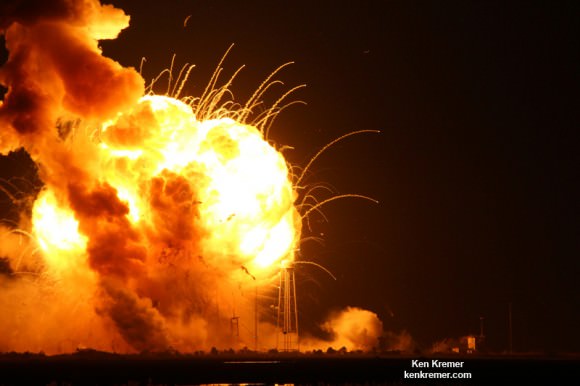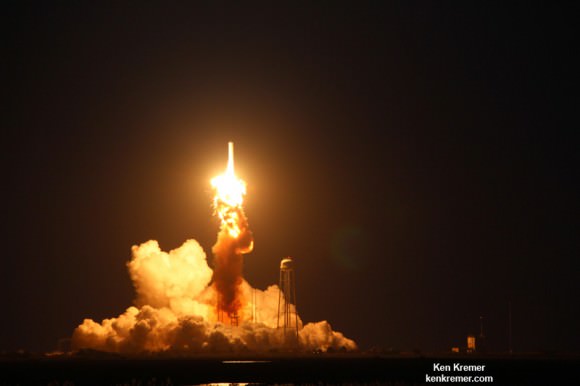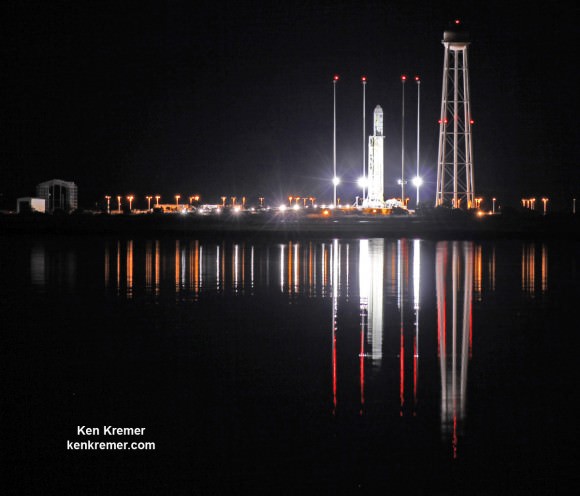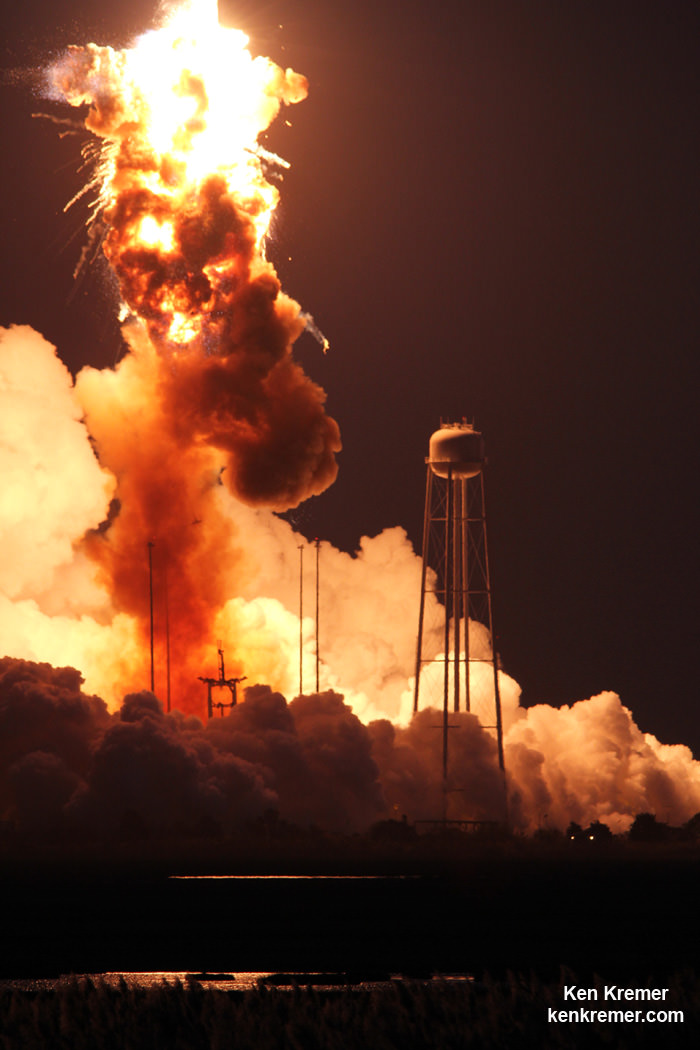NASA WALLOPS FLIGHT FACILITY, VA – Moments after a seemingly glorious liftoff, an Orbital Sciences Corp. commercial Antares rocket suffered a catastrophic failure and exploded into a spectacular aerial fireball over the launch pad at NASA’s Wallops Flight Facility on the eastern shore of Virginia that doomed the mission bound for the International Space Station on Tuesday, October 28.
The 14 story tall Antares rocket blasted off at 6:22 p.m. EDT from the beachside Launch Pad 0A at the Mid-Atlantic Regional Spaceport (MARS) at NASA Wallops on only its 5th launch overall.
I witnessed and photographed the launch from the media viewing area on site at NASA Wallops from a distance of about 1.8 miles away.
This story is being updated. See a gallery of photos herein.
Antares was carrying Orbital’s privately developed Cygnus pressurized cargo freighter loaded with nearly 5000 pounds (2200 kg) of science experiments, research instruments, crew provisions, spare parts, spacewalk and computer equipment and gear on a critical resupply mission dubbed Orb-3 bound for the International Space Station (ISS).

It was the heaviest cargo load yet lofted by a Cygnus. Some 800 pounds additional cargo was loaded on board compared to earlier flights. That was enabled by using the more powerful ATK CASTOR 30XL engine to power the second stage for the first time.
Everything appeared normal at first. But within about five seconds or so there was obviously a serious mishap as the rocket was no longer ascending. It was just frozen in time. And I was looking directly at the launch, not through the viewfinder of my cameras.
Something was noticeably amiss almost instantly as the rocket climbed only very slowly, barely clearing the tower it seemed to me. The rocket failed to emerge from the normal huge plume of smoke and ash that’s purposely deflected away by the flame trench at the base of the pad.
I was stunned trying to comprehend what was happening because it was all so wrong.
It was absolutely nothing like the other Antares launches I’ve witnessed from the media site.

I knew as a scientist and journalist that I was watching a mounting disaster unfolding before my eyes.
Instead of ascending on an accelerating arc, a mammoth ball of fire, smoke and ash blew up the entire sky in front of us like a scene out of hell or war. Literally the sky was set on fire unlike anything I’ve ever witnessed.
A series of mid air explosions rocked the area. I could feel a slight pressure wave followed by a mild but noticeable heat wave passing by.
Then the rocket began to fall back to Earth. Then the ground blew up too as the rocket pieces hit the ground and exploded into a hail of smithereens in every direction.
By this time our NASA escorts starting yelling to abandon everything in place and head immediately for the buses and evacuate the area. The ground fire spread mostly to the northern portion of the pad and the expanding air borne plume also blew northwards. The ground fire was still burning over a half hour later.
Thankfully, everyone got out safe and there were no injuries due to the excellent effort by our NASA escorts trained for exactly these types of unexpected circumstances.
It’s heartbreaking for everyone’s painstaking efforts to get to the point of liftoff after years of effort to fulfill the critical need to resupply that station with the science equipment and experiments for which it was built.
More later

Watch here for Ken’s onsite reporting direct from NASA Wallops.
Stay tuned here for Ken’s continuing Earth and Planetary science and human spaceflight news.


BBC World News video http://www.bbc.co.uk/news/world-us-canada-29812139 Nasty. You have to be impressed by the resilience of that tower though.
YES! The water tank and tower withstood the blast and looks like most of the fuel tanks surrounding the launch pad! The damage doesn’t look all that bad. Here is the photo of the pad from NASA – http://www.nasa.gov/press/2014/october/nasa-s-wallops-flight-facility-completes-initial-assessment-after-orbital-launch/#.VFGMbfnF-KR
The loss of this Antares will likely cause cancellation of at least one, probably two, Antares-Cygnus trips to ISS. Such cancellations will probably cause significant changes to SpaceX Dragon resupply mission manifests.
Its a risky business launching rockets – Watching the scene in the movie ‘The Right Stuff’ reinforces the point well showing the dozens of launch failures NASA had developing its rockets.
I continue to applaud NASA’s decision to outsource their LEO transport for crew and cargo to private providers – even if one particular provider is having problems, it’s worth it in the long run to support having a diverse market which can eventually takeoff into a full-fledge commercial space transport market available to the average consumer…